 Did You Know?
Did You Know?by Chip Brooks Article #21 |
 Did You Know?
Did You Know?by Chip Brooks Article #21 |
|
I started my research for this article over 2 years ago. Having run into a number of dead ends along the way, I have dropped the research, then started again, then stopped, etc. At this point I don't feel that anything new will be discovered until 'you' the reader's worldwide have an opportunity to respond to this article.
Did You Know? One of the more interesting labels that I have collected over the years is that of a rowdy group of black men during an obviously disorganized lodge meeting. The image is very old, ©1883, very colorful, very creative artistically and conceptually and to top it off...pretty darn scarce. I believe the initials on the drum stand for 'Ithaca Cigar Manufacturing Co.' for whom the label was originally made. The litho company was Mensing & Stecher, NY.
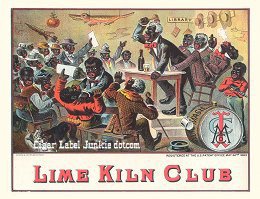
As is my nature when I am around the long time label collectors, dealers and history buffs, I tend to ask a lot of questions, throw out ideas about future articles or inquire about the possible origins of a particular label. At one of the local gatherings I asked if anyone had any information on the Lime Kiln Club. It was mentioned that there was a book about the club. I thought that was a great lead and started asking around if anyone had a copy of the book. The results of the query produced two possibilities at that time: David Beach and Rupert Knowles. Of course David wanted me to buy the book, not borrow it, but Rupert was very gracious and allowed me to spend some quality time with his very expensive ©1882 '1st Edition'. Thanks Rupert...
More on the book later...
During my searches on the Internet and in conversations with real live people, I have found a few additional images and interesting tidbits of info that relate to the Lime Kiln Club. There is a second LKC label that was produced by the Calvert Litho Co. It is much rarer than the Mensing & Stecher litho and pictures a more organized and well mannered lodge meeting. I'll bet that very few of you have seen this version before?
 (Calvert Litho) In 1886, Dixon's Stove Polish recruited Brother Gardner (president of the LKC) and the members of the Club to endorse their product on a Trade Card (an 1800's commercial). On the back of the trade card Brother Gardner talked about the Club's stove committee (one of many LKC's committees) and the qualities of Dixon's stove polish: "Dis Club hab ebery reason to be proud of de Stove Committee. De honah of dis occashun belongs to Brudder Shindig, who has made a name for hisself, by introducing Dixon's Big Cake of Stove Polish, and has covered hisself wid shine."
 (Dixon's Stove Polish Trade Card) Over the next several years the Club's praises were set to music. There were several songs written and published about the Lime Kiln Club. One of the songs was ©1900, indicating the Club was still very popular some 20 years after the first book was published.
In 1949, A. D. Faber produced two books about cigar labels - "Cigar Label A-R-T" & "Smokers, Segars & Stickers". The unique packaging for the 2 book set was an actual cigar box with the title: "Cigar Label Art" (more than likely Faber coined the phrase "Cigar Label Art").

In the "Cigar Label A-R-T" book, there were actual examples of cigar labels. The featured 'fold out' label in most of the books was the Lime Kiln Club. Although in Judy Hill's cigar box set of the books, the LKC label was replaced by a pretty nice substitute label...Our Club Rooms.

According to Dr. Tony Hyman a lot of info in the books was incorrect or fabricated. I feel that the real value of this set lies in the unique packaging and the original cigar labels found within.
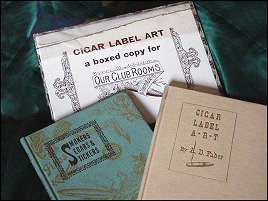
This set of books would make a nice addition to your collection. Also, I understand that there is a Tobacco trade card for the Lime Kiln Club but have not been able to locate the image at the time of this writing.
Side Note 3-1-04: Found one-albeit poor quality...

Back to the Book...
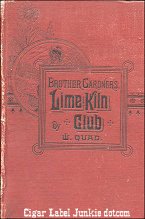 (LKC 1st Edition)
As far as I know there are 3 versions of the book. The 1st Edition ©1882, the paper back edition ©1888 and the 3rd edition (the one I now own) ©1894. The book was written by 'M. Quad and Brother Gardner'. The title page of the book has the following statement:
"Brother Gardner's Lime-Kiln Club, being the regular proceedings of the regular club, for the last three years. With some philosophy, considerable music, a few lectures and a heap of advice worth reading. Not compiled in the interests of Congress or any Department of the Government."
The dedication of the book was written by the president of the Lime-Kiln Club, Brother Gardner:
"Dedicated the Members of the Detroit Lime-Kiln Club and to the friends and well wishers of the colored man in America."
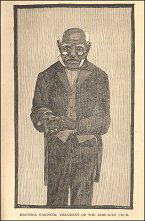 (Brother Gardner) The Lime-Kiln Club members were very interesting characters. Their names echoed the humor and dialogue that runs throughout the book. Brother Gardner was the leader and then there was Bro. Shindig, Stepback Smith, Give-A-Dam Jones, Accordingly Davis, Stepoff Johnson, Sir Isaac Walpole and Layback Jones to name a few.
 (LKC 3rd Edition)
The book related the Club's views on everything from the weather to politics, agriculture, astronomy, poetry and music. Many of the Club's points of view would still be valid today, some 120 years after the book was published. The book is a tough read though...the dialogue is written in the colloquial vernacular of the Negro plantation worker of that era.
Here is an example:
As I read more of the book, I began to realize that the Club's members were professional people such as doctors, lawyers, judges, ex-military officers, teachers and generally very well educated men. I couldn't understand why they would be using this type of uneducated vernacular and why the names of the characters really didn't match their professions. My curiosity piqued, I found myself flipping quickly to the front of the book (well as quickly as one can flip through a 120 year old book) and noticed opposite the title page that there was a pic of the author M. Quad along with some of the characters featured in the book. I thought that was pretty interesting because M. Quad was a white dude and that didn't fit in with the style of verbiage being used.
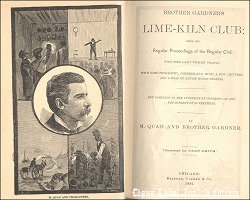 (LKC 1st Edition Title Page)
So I started doing the research thing again to find out more about the author. I found that M. Quad was a pseudonym for a Chicago newspaperman: Charles Bertrand Lewis. My searches to find out more about Mr. Lewis were very skimpy at first, but then the hammer dropped...one of the searches produced this:
Satirist?!? All of this work researching (no wonder I ran into so many dead ends), reading and finding images related to the Club...and the darn thing never existed. This guy actually created and perpetuated a myth about a Club that obviously received national play from several different sources for over 20 years. This is equivalent to a white actor on stage wearing 'black face'. What a remarkable feat...this was 120 years ago...no radio, television or the Internet...just word of mouth about a Book and a Club...what an amazing farce!
 (M. Quad - Charles Bertrand Lewis) Now What?¿? How do I verify that the Club DID NOT exist? I wrote to the library historian at the Detroit Press and asked if they had any info on the LKC...they replied with, "I could not verify or find any record that the Club ever existed, but that doesn't mean it didn't." I presented my findings to a couple of ephemera history experts: Dr. Tony Hyman replied that the Club did not exist and Dave Mihaly, Curator of the 'John Grossman Collection of Antique Images' really couldn't verify the Club's existence one way or the other.

So there you go...Two years of research and I haven't been able to prove or disprove anything except...the Lime Kiln Club is a great image with an even greater history or non-history if you prefer.
I will leave the final decision up to you: The Lime Kiln Club - Fact or Fiction?
Hope you enjoyed the info...until next time,
|

